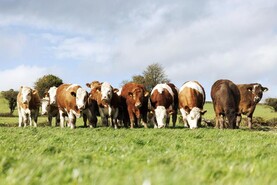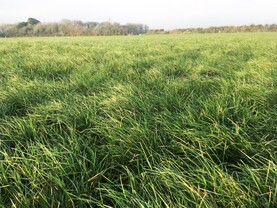Weather
Rainfall for the last week is between two and three times the normal amount. Given that rainfall for the last six months was well above normal, ground is saturated.
We normally get some dry spells,but that hasn’t happened so far this spring, with near constant rain in February and March.
It’s presenting big problems for those running low on silage and running out of slurry storage, on top of the extra workload and cost burden.
The forecast is a bit better than it was, but there is still more rain to come and those on heavy soils need land to dry out. Realistically, it could be early April before the situation changes for those on heavy soils.
There is a lot of silage on the move around the country, so there are plenty of farmers feeling the pinch. Measure what silage is left now and work out how long that will last for.
Alternatives such as soya hulls or palm kernel are available, but are not cheaper than silage and can be tricky to feed out.
Heifers
Over the last few years, there has been a big increase in the number of herds practising fixed time AI on maiden heifers. This is where heifers are given a CIDR or coil device along with other hormones and inseminated at a set date and time.
Many have combined this with sexed semen. Results have been mixed, with some big variations in performance between farms, ranging from 30% to 70% conception rate. The average conception rate in the Moorepark heifers has been around 55%.
One of the areas that researcher Stephen Butler has identified for poor results is heifers being too light at mating and not cycling. Heifers should be 60% of their mature liveweight at breeding time, which is 348kg if they are to be 580kg when mature.
To be very accurate, one could take the EBI for maintenance sub-index of the heifers and work out their expected mature liveweight from that.
A maintenance sub-index of zero is a mature weight of 640kg, and every €1 change is equivalent to 5kg liveweight. So if the heifers have an average maintenance sub-index of €14, then the mature liveweight should be 570kg and they should be 342kg by May.
If they do 0.8kg liveweight/day between now and then, they should be 310kg today. It’s the bottom 20% to 30% that you need to worry about. Turn them out to grass now where possible, or give them extra meal.
Meanwhile, AI companies are reporting a huge increase in demand for sexed semen, so get orders in now.
OAD
If there’s one thing that will strip condition off cows, it’s mediocre quality silage combined with a touch of lameness.
Lameness seems to be a bigger issue this spring compared to other years, and because many herds have been eating more silage than grass, the period of negative energy balance has been prolonged this spring.
There’s a big risk that cows will drop out of the system as a result of being too thin or not recovering from lameness in time for breeding.
The weather will change and more grass in the diet will help, but combining this with once-a-day milking for these at risk cows will be a big help at moving the dial between weight loss and weight gain.






 This is a subscriber-only article
This is a subscriber-only article











SHARING OPTIONS: